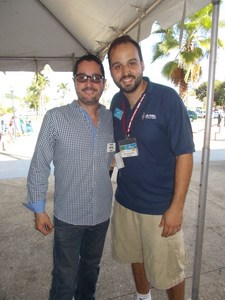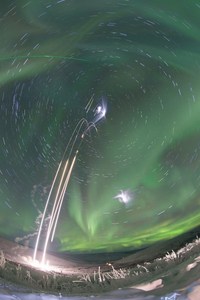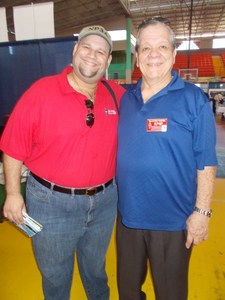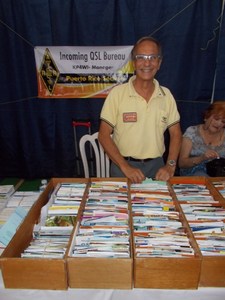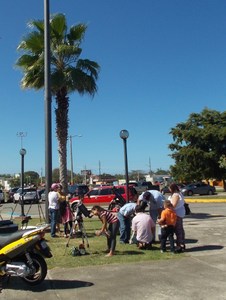 January 28, 2015 Editor: Ward Silver, NØAX | |||||||
IN THIS ISSUE
NEW HF OPERATORS - THINGS TO DO Now it's your turn to be an on-the-air or in-the-shack Elmer! The School Club Roundup is a great opportunity to help students and other new hams successfully make contacts. Starting on February 9th, they'll probably be on mostly after school but listen for the teams any time! There are a couple of fast-paced sprint contests, too - the newly re-sponsored SSB Sprint is this weekend and the NCJ-sponsored CW Sprint follows on the next weekend. BULLETINS There are no bulletins in this issue BUSTED QSOS Errors in the previous issue were apparently hard to find! CONTEST SUMMARY Complete information for all contests follows the Conversation section January 31-February 1
February 7-8
At the ARRL Board meeting on January 16-17, changes were approved to the DXCC program rules regarding remote operation and to the VHF+ contest program rules. The DXCC changes aligned the awards's rules with those of the ARRL contest program which have been in effect for several years. The new rules for VHF+ contesting go into effect with the June VHF Contest and allow the use of spotting assistance, self-spotting, and multiple-band transmissions in all categories of operation. Updates to the online rules for both DXCC and contests will be published soon.
Reverse Beacon Network (RBN) contributors (current or prospective) can now find everything they need online to be able to send CW and RTTY Skimmer Server spots to the RBN using a single Aggregator and a single QS1R SDR receiver. The information, plus a new version of Aggregator is all on the RBN website in three relatively small downloads. (Thanks, Pete N4ZR) It's hard to remember the days before integrated circuits! Here's an interesting history, "25 Microchips That Shook The World" from IEEE Spectrum. One of my favorites is missing but it's hard to argue that the collection in the article weren't important. (Thanks, Dennis N6KI) Imagine a multi-dimensional hamfest and you have...a Maker Faire! Here are four upcoming events that will have something fun for every ham including a combo with the South Florida Tropical Hamboree:
There are a lot of interesting protocols being devised for HF data. To test out their creations, inventors usually get an experimental license from the FCC. From the list of those licenses and the stated purpose behind them, we can get an idea of what technology might be headed our way! (Thanks, Tim K3LR) A updated prediction for future solar cycles has been released by NASA. I can't say 10 meter fans will be very happy but the low banders are probably celebrating in the streets! Summarizing the report, "Cycle 24 will be a low cycle very likely to be followed by several other low or even lower cycles - supported by the current and historical data. Make the most of the current band conditions and upcoming DXpeditions - it certainly looks as if we are heading toward a 'Propagation Winter.'" (From ARRL Propagation Bulletins ARLP003 and ARLP004) Maybe these fancy sunspot spectacles will help out with propagation and speaking of Gotham beams, they aren't all off the air. The story "W3AU, VU2MV, VU2JN and the Gotham Beam!" tells the tale of one such monobander put to work once again. (Thanks, Tim K3LR) Could that gigantic radio burst detected from 5.5 billion light years away just be some alien amateur testing a new solar-system-sized amplifier? Or maybe it was just the start of a CQ Galaxy-Wide Contest! Maybe it was a very short DXpedition to a black hole - "This was our first view of the AHHHHHHHhhhhhh....!
The Super Check Partial (SCP) databases used by most contest logging software is maintained by Stu K6TU. He is preparing an update to the database and requests that you send him recent contest logs. More info on the SCP database and contributing logs is available online. The Missouri QSO Party, coming up on April 4-5, has made some major changes to the exchange, bands, modes, and other rules this year. Be sure your logging software supports these changes. (Thanks, George ABØRX) Following up on the recent article about the National Radio Quiet Zone and the people who flock there, the ARRL relayed a note from Rob N3RW about getting permission to use the HF Bruce Array at the National Radio Observatory's entrance. On 17 meters, few stations were willing to believe he was running just 5 watts! The Bruce Array at the entrance to the Green Bank site is a rebuild of the antenna used by physicist Karl Jansky who in the 1930s studied radio noise for the Bell System's HF radio circuits. More about Jansky and the antennas can be found in ARRL Propagation Bulletin ARLP004. Web Site of the Week - Stu K6TU has automated the process of generating terrain profiles for use with N6BV's HF Terrain Analysis (HFTA) program. To support HFTA's modeling, a user must first obtain a terrain profile which describes the height of terrain around the antenna location. This process is cumbersome and time consuming as the source of the data must be located, downloaded, then processed with MicroDEM. Terrain Profile Requests are available to any user with a registered account on K6TU.NET at no charge and no subscription to Stu's propagation prediction service is necessary. Stu's site maintains copies of both the USGS National Elevation Dataset (for the United States) and the NASA Shuttle Radar Topography Mission dataset enabling fast turnaround of requests. WORD TO THE WISE In line with this issue's Conversation piece, what are all those Field Day class abbreviations, anyway? The Utah Amateur Radio Club figured them all out and posted an explanation on their website. (Scroll down to see the list.) Now all we have to do is pick one - hmmmm, 2B or not 2B, that must be the question! (Thanks, Tim N9PUZ)
A geomagnetic storm erupted during the early hours of January 26th, sparking a surprise display of bright auroras around the Arctic Circle. Scientists took the opportunity to launch four sounding rockets from Alaska's Poker Flat Research Range to study the effect of solar storms on the upper atmosphere. You can see a picture of the colorful launch at right and more information is available in the Spaceweather archives for that date. Here's a great review of the last 25 years of the Hubble Space Telescope, including some astonishing images (and some new ones). A ham radio note - Sandra Faber (married to Andy AE6Y) was the scientist who figured out what was wrong with Hubble's mirrors and how to fix it. She was recently awarded the National Medal of Science - well done! (Thanks, Bob N6TV) What really is the difference between a hard drive (HD) and a solid-state drive (SSD)? This video explains the two technologies and shows how they are constructed. What would have happened if Google had been invented in the 1960s? Let's just say you'd be playing with a full deck! (If you get that joke, you're officially a computer science old-timer.) And you can play Spacewar on it, too, the game with the first-ever hyperspace button. The ARRL Contest Branch's Contest Results Page is a busy place these days as both sets of preliminary results for the November Sweepstakes by VE4XT (CW) and N2IC (Phone) have been posted. The complete 2014 IARU HF Championship package is about to be published as soon as staff can return to work after the snow, including the full results by Nate N4YDU which are already published, Line Scores in an expanded format developed by John K9JK; and Log Checking Reports. (The latest IARU results have changes in the Top Ten tables for CW QRP due to a disqualification.) Plus, PDF versions of the QST articles for the August UHF and 10 GHz and Up Contests are now available. (Thanks, ARRL Contest Branch Manager, Matt W1MSW)
The June VHF Contest section records have been updated through 2014 and are now on the ARRL Contest Records web page. In addition, the CQ WW VHF Contest High Score Lists through 2014 have been posted. Please contact Curt K9AKS with additions or corrections. OPERATING TIP What happens if you enter "Cut Numbers" in QSO lines of a Cabrillo-formatted log? You'll be hearing lots of them in the upcoming ARRL DX CW Contest, so here's the straight scoop. First, the character string is read from the submitted log. Then...
Rather than learn about receiver front-end protection the hard way, Pete N4ZR developed his front-end protector with the help of George W2VJN. It costs less than $5 and is easy to build, too! The article "Satellite Anatomy 101" in EDN magazine is a great overview of commercial satellite technology. Amateur satellite users will also find a lot of useful information there. Frank KR1ZAN relays word of an Instructables project with some ideas on "dead bug prototyping" and creating some electronic conversation pieces. He also provides the hot tip that Dremel has released a new line of VersaFlame⢠and VersaTip⢠butane torches.
Here are a couple bargain-hunter tips from Evan K9SQG: Full-circumference fuel line clamps from an auto parts store can be used to hold shield braid on the connections of a vacuum relay. For restoring bases of microphones and other appliances, you'll find adhesive-backed felt in fabric stores. (Thanks, Evan K9SQG) Two recent articles in the January 2015 issue of High Frequency Electronics are of interest to amateurs: "Changing the Operating Frequency of an RF Power Amplifier" by Donna Vigneri KF7SJF and "Achieving First-Pass Success in PCB-Based Filter and Matching Circuit Designs" by Muir, Dunleavy, and Weller. The issue is available in the online archives. The day of not having to etch away copper to create a printed-circuit board seems to be here. Finally, the name "printed-circuit" is accurate! The new Voxel8 3D printer uses a new silver-based highly conductive ink instead of the carbon-based inks in previous printers. (Thanks, Dennis N6KI) Field emission devices are starting to get some attention again as described in the IEEE Spectrum article, "Introducing the Vacuum Transistor: A Device Made of Nothing". (Thanks, Bill W8LV) Technical Web Site of the Week - Eric NO3M has developed quite a system for distributing the signals of receive antennas to a variety of receivers. He wrote it up as an article published in the May/June 2012 issue of the National Contest Journal. It can handle up to 128 physical antennas and four receivers, controlled via an RS-485 serial interface. Field Day - Ham Radio's Open House With a blizzard blanketing our New England hams, isn't it a bit too early to be thinking about ARRL Field Day? (I hear all of you Field Day committees laughing out there!) Successful planning is already getting underway and may have been going on for some time. Having been on both sides of the fence, I can tell you that waiting until April to start the process is a good way to miss the boat! Knowing that my readers include leaders from across the amateur spectrum, I ask, "How can we make a difference?" Last year was a time of celebration and reflection on our first century but it's time to take off the party hats and look to the future. Our society is awash in wireless technology and users of it. Let's take our story to those users, awaken them to the presence of radio among them, and show them how they can participate, whether from a scientific interest, to provide a service to their fellow citizens, or simply to enjoy connecting with other peoples.
Instead of hiding our Field Day operations in some out of the way location, set up shop where the public can't possibly miss noticing your activity. After all, following a disaster, it's likely that you'll be providing public service from just such a location, so it's good practice. Imagine your group operating from a city park or the local sports field complex, attracting a steady stream of passers-by, kids between games, families out for a picnic, a bicycle club - anyone having some weekend fun. "What is this beehive of activity with the antennas and tents? It's a ham radio open house, and look, they have free coffee and cookies!" Ten minutes later, they're on their way with some information in their heads and a handout in their pocket, or better yet, they've stored your club's website address in their smartphone. They now know a lot more about Amateur Radio than they did at breakfast! Field Day is structured perfectly to act as our version of "open house." A typical group will be active on HF with voice, supported by CW and digital mode operation. Taking advantage of the "free" VHF station, an all-band rig will be making QSOs on 6 meters and up with some simple antennas on a temporary mast. Someone will have an FM rig monitoring the talk-in and simplex channels for a few more QSOs. Someone else will set up an alternative power source since the bonus points encourage innovation and experimentation. A Get On The Air (GOTA) station will allow visitors to try voice or PSK31 contacts. The ARES folks might bring their comm trailer or set up a portable station. That all-important radiogram to the Section Manager could be sent through the Winlink system. Here, take a look at this APRS map! And so forth. I assume that I have lots of experienced readers with a lifetime of operating and station construction experience. Let's put that to work showing our fellow citizens what we're about. While the late-night CW shift is important, become a ham radio ambassador for the weekend, as well. Instead of focusing exclusively on QSO totals, make your metric for success the number of flyers, business cards, and QR code scans you disburse to the visitors. We all know a friendly CQ will bring out the callers and so, too, will a welcoming layout encourage visitors to take a look. Instead of setting up what looks like a crime scene investigation or a defensive perimeter around Fort Wireless, make it easy for someone to overcome their natural hesitancy and visit our world. Even better, go out to where they are, invite them in, and ask them about their interests! Assign your group's chattier members to show them around. Create a Visitor's Logbook and record each Visitor QSO with just as much relish as working a new section. Get their contact information and follow up afterwards with more radio goodies and an invitation to a club function geared toward the non-ham. Be ready for the inevitable "Do you still do that?" question with "Not only do we still do that but look at this!" It's a pretty safe bet that most of the public is completely unaware of what radio can do. Set up a long-distance WiFi link using the 2.4 GHz amateur channels with a cool-looking Yagi or "barbeque-grill" dish. Will there be a visible ISS pass around sunset? If so, help people see it for the first time and while you're at it, digipeat through its on-board packet system. Got a telescope? Point it at the Moon and invite one of the local moonbouncers to fire up and bounce a signal off the lunar surface. Set up a workbench and use the time to build a kit, make cables, assemble an antenna, write a program...do stuff! The future of Amateur Radio depends on us. The ARRL can open doors, provide materials, suggest and share ideas, but individual hams have to close the sale, just as our Elmers did for us. We can't do it behind closed gates. After all, "The more you do anything that don't look like advertising the better advertising it is." said Will Rogers. Now it's open house, are we ready? 28 January through 10 February An expanded, downloadable version of QST's Contest Corral in PDF format is available. Check the sponsor's Web site for information on operating time restrictions and other instructions. HF CONTESTS North American Sprint--CW, from Feb 8, 0000Z to Feb 8, 0359Z. Bands (MHz): 3.5-14. Exchange: Both call signs, serial, name, and S/P/C. Logs due: 7 days. Rules School Club Roundup--Phone,CW,Digital, from Feb 9, 1300Z to Feb 13, 2359Z. Bands (MHz): 1.8-28, 50+. Exchange: RS(T), Class, S/P/C. Logs due: 15 days. Rules Feld-Hell WAAAEO Sprint--Digital, from Jan 31, 0000Z to Jan 31, 2359Z. Bands (MHz): 1.8-28, 50. Exchange: RST, S/P/C, Feld-Hell member nr. Logs due: 7 days. Rules UBA Contest--Phone, from Jan 31, 1300Z to Feb 1, 1300Z. Bands (MHz): 3.5-28. Exchange: RS, serial, and ON province. Logs due: 2 weeks. Rules SSB Sprint--Phone, from Feb 1, 0000Z to Feb 1, 0400Z. Bands (MHz): 3.5-14. Exchange: Both call signs, serial, name, and S/P/C. Logs due: 7 days. Rules OK1WC Memorial Contest--Phone,CW, from Feb 2, 1630Z to Feb 2, 1730Z. Bands (MHz): 3.5, 7. Weekly on Monday, see website for bands. Exchange: RS(T) and serial. Logs due: 5 days. Rules ARS Spartan Sprint--CW, from Feb 3, 0200Z to Feb 3, 0400Z. Bands (MHz): 3.5-28. Monthly on the first Monday evening local time. Exchange: RST, S/P/C, and power. Logs due: 2 days. Rules CWOps Weekly Mini-CWT Tests--CW, from Feb 4, 1300Z - See website. Multiple time periods. Bands (MHz): 1.8-28. Weekly on Wednesday, 28 to 38 kHz above band edge. Exchange: Name and member number or S/P/C. Logs due: 2 days. Rules NS Weekly RTTY Sprint--Digital, from Feb 6, 0145Z to Feb 6, 0215Z. Bands (MHz): 3.5-14. Weekly on Thursday evenings local time. Exchange: Serial, name, and S/P/C. Logs due: 2 days. Rules NS Weekly Sprint--CW, from Feb 6, 0230Z to Feb 6, 0300Z. Bands (MHz): 1.8-14. Weekly on Thursday evenings local time. Exchange: Serial, name, and S/P/C. Logs due: 2 days. Rules YL-OM Contest--Phone,CW,Digital, from Feb 6, 1400Z to Feb 8, 0200Z. Bands (MHz): 1.8-28. Exchange: Call sign, RST, serial and S/P/C. Logs due: 30 days. Rules Triathlon DX Contest--Phone,CW,Digital, from Feb 7, 0000Z to Feb 7, 2359Z. Bands (MHz): 3.5-28. Exchange: RS(T) and serial. Logs due: 28 Feb. Rules Vermont QSO Party--Phone,CW,Digital, from Feb 7, 0000Z to Feb 8, 2400Z. Bands (MHz): 1.8-28, 50,144. Exchange: RS(T) and VT county or S/P/C. Logs due: 30 days. Rules YLISSB QSO Party--CW, from Feb 7, 0000Z to Feb 8, 2359Z. Bands (MHz): 1.8-28. Exchange: Call sign, RS(T), ISSB number. Logs due: Mar 21. Rules Ten-Ten Winter Phone QSO Party--Phone, from Feb 7, 0001Z to Feb 8, 2359Z. Bands (MHz): 28. Exchange: Call sign, name, QTH, 10-10 number. Logs due: 15 days. Rules Black Sea Cup International--Phone,CW, from Feb 7, 1200Z to Feb 8, 1159Z. Bands (MHz): 1.8-28. Exchange: RS(T) and HQ ID, member nr or ITU zone. Logs due: 30 days. Rules Straight Key Weekend Sprintathon--CW, from Feb 7, 1200Z to Feb 7, 2359Z. Bands (MHz): 1.8-28, 50. Exchange: RST, QTH, name, member nr if member. Logs due: 5 days. Rules FYBO Winter QRP Field Day--Phone,CW, from Feb 7, 1400Z to Feb 7, 2400Z. Bands (MHz): 1.8-28. Exchange: RS(T), S/P/C, name, power, temp in deg F. Logs due: 30 days. Rules Minnesota QSO Party--Phone,CW,Digital, from Feb 7, 1400Z to Feb 7, 2359Z. Bands (MHz): 1.8-28. CW 1.850, 3.550, 7.050, 14.050, 21.050, 28.050; SSB 1.870, 3.850, 7.250, 14.270, 21.350, 28.450 MHz. Exchange: Name and MN county or S/P/C. Logs due: Mar 15. Rules Straight Key Party--CW, from Feb 7, 1600Z to Feb 7, 1900Z. Bands (MHz): 3.5. Exchange: RST, serial, category, name, age. Logs due: Feb 28. Rules British Columbia QSO Party--Phone,CW,Digital, from Feb 7, 1600Z to Feb 8, 0400Z. Bands (MHz): 1.8-28. CW 1.815, 3.535, 7.035, 14.035, 21.035, 28.305; SSB 1.845, 3.85, 7.23, 14.25, 21.3, 28.4 MHz; Digital per band plan. Exchange: RST and BC district or S/P/Territory or DX. Logs due: Mar 31. Rules XE Int'l RTTY Contest--Digital, from Feb 7, 1800Z to Feb 8, 1759Z. Bands (MHz): 3.5-28. Exchange: RST and XE state or serial. Logs due: 30 days. Rules AM QSO Party--Phone, from Feb 7, 2300Z to Feb 8, 2300Z. Bands (MHz): 1.8-14. Exchange: RS, name, and S/P/C. Logs due: 4 weeks. Rules Classic Exchange--Phone, from Feb 8, 1400Z to Feb 9, 0800Z. Bands (MHz): 1.8-28, 50,144, AM--1.890, 3.880, 7.160, 7.290, 14.286, 21.420, 29.000, 50.400, 144.300; SSB--1.885, 3.870, 7.280, 14.270, 21.370, 28.390, 50.125, 144.200 MHz. Exchange: RST, QTH, model of rcvr and xmtr. Logs due: 30 days. Rules VHF+ CONTESTS School Club Roundup--Phone,CW,Digital, from Feb 9, 1300Z to Feb 13, 2359Z. Bands (MHz): 1.8-28, 50+. Exchange: RS(T), Class, S/P/C. Logs due: 15 days. Rules Worldwide EME Contest--Phone,CW, from Jan 31, 0000Z to Feb 1, 2400Z. Bands (MHz): 144, 432. Exchange: TMO/RS(T) and "R". Logs due: Jun 15. Rules Vermont QSO Party--Phone,CW,Digital, from Feb 7, 0000Z to Feb 8, 2400Z. Bands (MHz): 1.8-28, 50,144. Exchange: RS(T) and VT county or S/P/C. Logs due: 30 days. Rules Straight Key Weekend Sprintathon--CW, from Feb 7, 1200Z to Feb 7, 2359Z. Bands (MHz): 1.8-28, 50. Exchange: RST, QTH, name, member nr if member. Logs due: 5 days. Rules Classic Exchange--Phone, from Feb 8, 1400Z to Feb 9, 0800Z. Bands (MHz): 1.8-28, 50,144, AM--1.890, 3.880, 7.160, 7.290, 14.286, 21.420, 29.000, 50.400, 144.300; SSB--1.885, 3.870, 7.280, 14.270, 21.370, 28.390, 50.125, 144.200 MHz. Exchange: RST, QTH, model of rcvr and xmtr. Logs due: 30 days. Rules Milwaukee FM Simplex Contest--Phone, from Feb 8, 1900Z to Feb 8, 2130Z. Bands (MHz): 50-440. Exchange: Call sign and 4-char grid square. Logs due: Mar 16. Rules LOG DUE DATES January 28 through February 10
ARRL Information Click here to advertise in this newsletter, space subject to availability. Your One-Stop Resource for Amateur Radio News and Information ARRL membership includes QST, Amateur Radio's most popular and informative journal, delivered to your mailbox each month. Subscribe to NCJ - the National Contest Journal. Published bimonthly, features articles by top contesters, letters, hints, statistics, scores, NA Sprint and QSO Parties. Subscribe to QEX - A Forum for Communications Experimenters. Published bimonthly, features technical articles, construction projects, columns and other items of interest to radio amateurs and communications professionals. Free of charge to ARRL members: Subscribe to The ARRL Letter (weekly digest of news and information), the ARES E-Letter (monthly public service and emergency communications news), Division and Section news -- and much more! ARRL offers a wide array of products to enhance your enjoyment of Amateur Radio. Visit the site often for new publications, specials and sales. Donate to the fund of your choice -- support programs not funded by member dues! Reprint permission can be obtained by sending email to permission@arrl.org with a description of the material and the reprint publication. ACKNOWLEDGEMENTS ARRL Contest Update wishes to acknowledge information from WA7BNM's Contest Calendar and SM3CER's Contest Calendar. | |||||||
